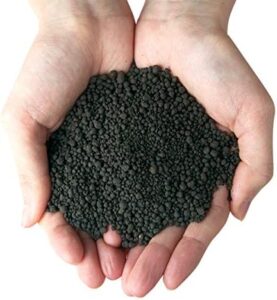
Aquasoil (there are various brands and types) is “an active bottom layer that lowers the pH value and slightly affects the water chemistry“. One aspect is to slowly leach out fertiliser into the water column over time. How about that ‘lowers the pH’ piece? One way would be to have the aquasoil directly add acid to the water but that wouldn’t last very long. Instead it is thought (although not published – trade secret) the aquasoil has an element of being an ion exchange matrix. This means there are charged surfaces on the aquasoil that can be pre-loaded with either positively charged (cations) or negatively charged (anions) molecules. These ions are slowly ‘exchangeable’ with ions of similar charge from the water column. For pH lowering purposes, the aquasoil would need to come pre-charged with H+ ions, possibly in the form of ammonium (NH4+), which can be exchanged for calcium (Ca++) or magnesium (Mg++) from the water column. The net effect would be to soften the water (removing Ca++/Mg++), add nitrogen based fertiliser (the ammonium) and to lower the pH of the water. All three of these effects are thought to be beneficial in a planted aquarium.
Aquasoil can run out of activity
Depending on how rapidly the ions exchange between the aquasoil and the water column, over successive water changes the aquasoil will have exchanged all the ions it came pre-loaded with and have reached an equilibrium state with the water where the water doesn’t change the aquasoil chemistry anymore, and the aquasoil doesn’t change the water chemistry anymore. At this point, the aquasoil has ceased being an active substrate and instead is a passive, purely physical support substrate.
The ion exchange process is generally reversible. If you flood the aquasoil with acid fertiliser you can in principle recharge it. This isn’t really practical – you’d be better off rescaping with fresh aquasoil.
Equilibrated aquasoil buffers against changing water chemistry
Since the aquasoil can both take up and release different substances, if your water chemistry were to change abruptly, the aquasoil would help resist that change. In principle, this is a good thing – stabilising your water parameters. However, what if you want to change your water parameters? Having recently converted the Shrimphaus to low alkalinity water, the old aquasoil is “resisting” the change. I put in low alkalinity water and carbonates absorbed by the aquasoil previously are now slowly released back into the water column, raising the alkalinity. Not to anything close to the alkalinity of Cambridgeshire tap water, but to a noticeable degree. Gradually the aquasoil will equilibrate to the new water conditions, but this might take several months. I’ll keep track here.
Shrimphaus evolving water chemistry
| Date | Elapsed time | Tank alkalinity | New water alkalinity | Tank alkalinity after water change |
|---|---|---|---|---|
| 27-Sep-2024 | 27 days | 69 ppm | 21 ppm | 30 ppm |
| 2-Oct-2024 | 32 days | 54 ppm | ||
| 5-Oct-2024 | 35 days | 66 ppm | 15 ppm | 24 ppm |
| 12-Oct-2024 | 42 days | 57 ppm | 12 ppm | 21 ppm |
| 14-Oct-2024 | 44 days | 39 ppm | ||
| 19-Oct-2024 | 49 days | 57 ppm | 9 ppm | 18 ppm |
| 26-Oct-2024 | 56 days | 51 ppm | 15 ppm | 30 ppm |
| 2-Nov-2024 | 63 days | 48 ppm | 18 ppm | 30 ppm |
| 10-Nov-2024 | 71 days | 45 ppm | 15 ppm | 33 ppm |
| 17-Nov-2024 | 78 days | 48 ppm | 18 ppm | 27 ppm |
| 22-Nov-2024 | 83 days | 42 ppm | 18 ppm | 33 ppm |
| 30-Nov-2024 | 91 days | 42 ppm | 21 ppm | 30 ppm |
| 8-Dec-2024 | 99 days | 51 ppm | 21 ppm | 30 ppm |
Gave up on aquasoil
The aquasoil really does a good job of hanging onto those ions! I decided a fresh start was warranted so I rescaped the shrimphaus and replaced the aquasoil with inert sand. Now the alkalinity holds steady at 30 ppm.